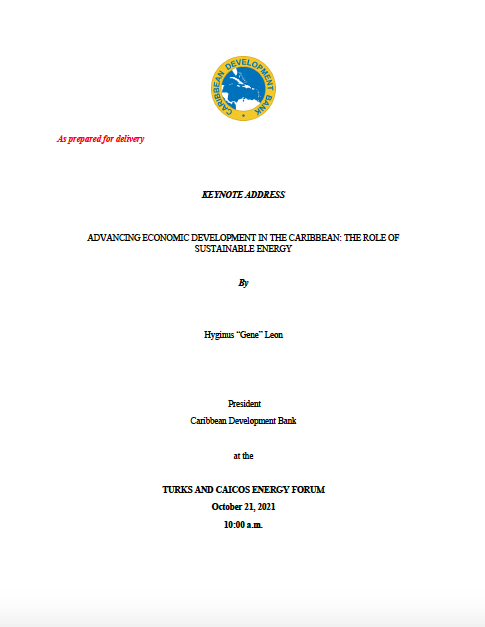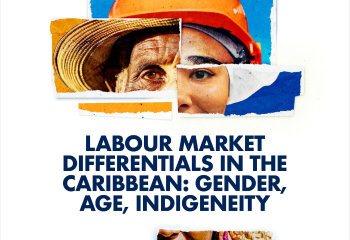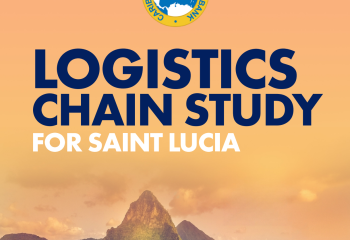Keynote Address: Advancing Economic Development in the Caribbean: The Role of Sustainable Energy
A. Introduction and Context
I consider it a privilege and feel especially honoured to have the opportunity to deliver this keynote address at this important and timely Stakeholder’s Energy Forum being hosted today in the Turks and Caicos Islands (TCI). As you know, TCI is well known, not only for its beautiful and scenic environment, but also for its bio-diversity and the oldest established salt-pan development in the Caribbean. This pristine environment is a sober reminder of how important it is to ensure that sustainable development remains at the heart of our growth and transformation strategy in the Caribbean region.
I would like to specially commend the organisers for putting together this important forum on energy, and for including as focal points for discussion, the issues of sustainability and resilience, topics which lie at the centre of the Caribbean Development Bank (CDB) and the region’s development and transformation agenda.
In today’s feature address, I plan to:
(a) explore the core pillars of a sustainable development strategy for the region;
(b) discuss the challenges to our development agenda posed by the current energy situation; and
(c) propose some key imperatives for a sustainable energy transition to advance the region’s development agenda.
My main message is that a sustainable energy transition is one of our most important transgenerational responsibilities. In that regard, we need to purposefully harness the almost unlimited supplies of solar, wind, and marine resources that are readily available in our environment in order to diversify our energy base and sustain the long-term development of our region.
B. Core Pillars of Sustainable Development and Sustainable Energy
Sustainable Development
What are the core pillars of sustainable development and sustainable energy that should inform our development strategy for the region?
Let me begin by introducing a concept of development that I have been actively promoting since assuming duties at the CDB six months ago.
In our Caribbean space, sustainable development must, of necessity, be holistic, inclusive, and multi-dimensional, and ought to ensure that our ecosystem is able to advance and self-perpetuate to guarantee our region’s survival and leave an inheritance for future generations. It must relate to that state of well-being that incorporates the economic, social, and environmental dimensions in which we carefully balance how we utilise and deploy our resources to meet our needs while safeguarding our natural environment. Without wanting to sound repetitive, it requires that we pay special attention to building resilient ecosystems, including social resilience (health, education, cultural mindset); institutional resilience (institutional capacity); production resilience (productive capacity in our green, blue, and orange economies, private sector development, overcoming external shocks (trade, spillovers)); financial resilience (financial management, availability and access to finance); and environmental resilience (recovering from natural disasters and hazards). Quite importantly, it also requires that we assess how the interaction of these elements impact our welfare.
Resilience, in turn, requires innovation. So, eliminating poverty, advancing standards of living, and delivering equitable prosperity by ensuring that no one is left behind will depend critically on our ability to innovate. Innovation in these buckets of resilience is what ultimately will give us the flexibility to adapt and respond appropriately as conditions evolve.
This all-embracing conception of development is an embodiment of our mission at CDB, which is focused on “Reducing poverty and transforming lives through sustainable, resilient, and inclusive development” and which is meant to ensure that development is distributed fairly across society, with opportunity for all. This very notion of holistic development is well encapsulated in the 2030 Agenda on Sustainable Development, which we in the Caribbean have signed on to and which has been given more concrete expression in the 17 Sustainable Development Goals (SDGs).
Sustainable Energy
What do we mean by sustainable energy and how does it interact with and contribute to the holistic development agenda?
For our Region, sustainable energy must include those forms of clean and renewable energy that enable us to meet the needs of the present generation without limiting the ability of our future generations to meet their own needs. In essence, we need to accelerate the generation of energy from renewable sources as well as improve our energy efficiency by utilising less energy to perform our daily responsibilities in the production of goods and services. As far as renewable resources are concerned, we have ample potential capacity in the region, especially from solar and wind, which are ubiquitous and freely available, and in some countries, we also have significant ‘hydro’ and geothermal resources. There are, as well, latent potential bioenergy resources from agricultural products, and significant potential for marine or ocean renewable energy, especially considering the large marine exclusive economic zone that encompasses several countries of the Caribbean archipelago.
Despite this obvious potential of renewable energy resources available to the Region, a recent report prepared by the Caribbean Centre for Renewable Energy and Energy Efficiency suggests that renewable energy penetration in our Region is still quite low relative to the global average. Recent estimates suggest that renewable energy penetration range from a low of 1 - 2 percent of installed capacity in countries like Trinidad and Tobago, Virgin Islands and, indeed TCI to a high of 25 - 35 percent in counties such as Dominica, Suriname, and Belize (notably those with a good hydro resource). The regional average is estimated at between 12 - 15 percent of total installed capacity, which remains low when compared with regional targets, such as those set out in the Caribbean Sustainable Energy Roadmap (or C-SERMS) of 47 percent by 2027.
Energy is an essential input into all economic activity and has critical ramifications in the social and environmental context. It is a vital pillar of the Paris Agreement on Climate Change and is enshrined in SDG7 of the 2030 Agenda for Sustainable Development. Important energy sub-goals associated with the SDG agenda include (i) ensuring universal access to affordable, reliable, sustainable, and modern energy services; (ii) increasing substantially the share of renewable energy in the global energy mix; (iii) doubling the global rate of improvement in energy efficiency; and (iv) enhancing international cooperation to facilitate access to clean energy research and technology; and (v) expanding infrastructure and upgrading technology.
United Nations’ Secretary-General, Ban Ki-Moon, captured this important connection between sustainable energy and sustainable development in the phrase “Energy is the golden thread that connects economic growth, social equity, and environmental sustainability”. We can further translate this into a few words: sustainable development is not possible without sustainable energy. It is worth remembering that energy correlates closely with many poverty indicators through its strong links with employment creation, income, education, health, gender, and environment, and is vital as such for attainment of overall development.
C. Core Energy Challenges Constraining our Development Agenda
While there are many challenges on the energy front that are hindering faster progress in advancing the Region’s development, I want to highlight four important ones that require some concerted and deliberate action on the part of our policy makers. These challenges revolve around an over-dependence on imported fossil fuels; a lack of energy security; the high cost of electricity; and an undiversified energy mix.
Over-dependence on Imported Fossil Fuel
Borrowing member countries (BMCs) of the CDB import more than 90 percent of their commercial energy supplies in the form of petroleum derivatives. This makes the Caribbean one of the most energy import-dependent regions of the world; and TCI, which imports more than 99 percent of its energy needs, is among the highest importers in this group. This reliance on fossil fuel is not sustainable given the negative impact of carbon emissions on the environment. And, while it is well established that the contribution to global stocks of carbon emissions from Caribbean countries and small island developing states, in general, is under one percent, we need to remain committed through our Nationally Determined Contributions to supporting climate mitigation by transitioning our energy systems away from fossil fuels.
Lack of Energy
Security Our over-reliance on imported energy has been one of the major factors contributing to the greater energy insecurity of our region. The United Nations Development Program (UNDP) defines energy security as the constant availability of energy in sufficient and affordable quantities without any adverse economic and environmental impacts (UNDP 2004). The demand and supply shocks associated with the COVID-19 pandemic have triggered volatility in energy markets, adversely impacting investments to supply energy in line with economic development and environmental needs. Furthermore, weaknesses in our energy system designs, including the electricity grids and the fuel storage and distribution networks make them highly susceptible to the impacts of natural hazards, such as hurricanes and floods, that are occurring at greater frequency in the region.
High Cost of Electricity
Owing to the small size of our markets, low economies of scale, and the prevalence in the use of diesel, which is the most expensive fossil fuel derivative for electricity generation, the price of electricity in our Region is among the highest in the world averaging USD0.28/kilowatt hour (kWh) in 2019. This is more than three to four times the average price in many of our trading partners in the developed countries. I understand that in TCI, average electricity prices are even higher than this regional figure, and range between USD0.35/kWh and 0.40/kWh. This high cost of imported diesel for electricity generation has steadily increased our import bill and worsened our terms of trade, eroded competitiveness, and stymied investment by the business community. High electricity costs are also having an impact on the more disadvantaged segments of the populations who spend a greater share of their disposable income on energyrelated costs (especially electricity and transportation).
Lack of a diversified Energy Mix
Energy diversification is critical for achieving energy security and the heavy dependence on one source of energy (mainly fossil fuels) implies that a failure or significant interruption to that source can impair economic and social activity. As a region, we need to embrace, rather quickly, the diverse range of energy alternatives that are in ample supply in our environment not only to mitigate ongoing energy-related shocks, but also to enhance our capability to rapidly adapt and maintain productive capacity in the face of these uncertainties.
D. Imperatives for a Sustainable Energy Transition to support Development and decarbonisation
So how do we go about harnessing the benefits of a sustainable energy to build resilience, contribute to carbon neutrality and drive our sustainable developmental goals in the Caribbean? Fortunately, our region has been considering this issue and, through an initiative at the CARICOM-wide level, developed and approved an energy policy that deliberately targets a shift towards sustainable energy, through the increased use of renewable energy sources and improvements in energy efficiency. TCI has also been making progress in laying an adequate foundation for advancing sustainable energy through the development of its renewable energy transition plan and has been taking additional steps to improve its regulatory framework.
At CDB, our Energy Sector Policy is aimed at embedding a sustainable energy framework at the national and regional levels based on the agreed regional energy policy priorities and with a laser focus on repositioning and sustaining the holistic development of our region.
Let me now lay out five critical priorities for a sustainable energy transition in the region:
Improving Energy Efficiency
First, we need to prioritise improving energy efficiency. Indeed, there are significant economic benefits from doing so. We know that improvements in energy efficiency (often captured by the energy intensity index for a country) in conjunction with investment in the sector have a positive impact on long run gross domestic product (GDP). International Monetary Fund research (2016) suggest that an improvement of one percent in energy efficiency could increase GDP per capita by around 0.2 percent in the long run.
For most of our countries, and indeed for TCI, a priority, therefore, is to ensure that, even with the current fuel source, we eliminate waste and losses in our utilisation of energy. Upgrading and adapting proven technology, as well as developing our own, while implementing relevant performance standards, regulatory instruments, and appropriate incentives/disincentives could entrench and bolster the much needed shift towards more energy efficient methods. Examples of immediate ‘low hanging fruit’ could include more efficient air-conditioning, dusk-to-dawn solar-based lighting (including street lighting), and refrigeration. At the regional level, CDB has already adopted the regional energy efficiency building code for application to relevant projects that we finance.
Embracing Diversification of Fuel Sources
Second, we must diversify our energy sources. Given the availability of solar, wind, and seawater resources in our BMCs, we should actively pursue the development of these technologies. A recent study by CDB and the Inter-American Development Bank on renewable energy technology options indicated that these sources could generate 50 to 100 times peak domestic electricity demand. In the Eastern Caribbean, the geothermal energy resource potential far exceeds their domestic demand. There are also emerging opportunities for using renewable energy to produce ammonia and green hydrogen which, many believe, could be a key fuel of the future. Diversifying our energy base could provide the basis for innovative projects that foster economic diversification, while achieving our sustainable development objectives.
We would also need to modernise our electrical energy systems to effectively incorporate and complement the new sources of energy to ensure improved reliability, stability, overall system efficiency, and resilience. This could be accomplished, for example, by hardening of the grid and incorporating flexibility through a mini/micro grid, smart technology applications, and energy storage solutions (such as battery energy storage systems).
Crowding-in the Private Sector Investment
Third, we need to encourage and incentivise our private sector to support this sustainable energy transition. With limited fiscal space available to governments, the private sector must play a leading role in driving this transition. There is more than enough room for households, micro, small and medium-sized enterprises (MSMEs), private utility companies, and large private independent power producers (including international) to invest in various sustainable energy transition projects with an expectation of reasonable returns while simultaneously supporting common sustainability goals. Governments would need to facilitate this participation through appropriate enabling frameworks that are inclusive, supportive, and consultative. An independent regulatory framework model rooted in a performance-based approach is likely to be an appropriate choice for BMCs.
Building Strategic Partnerships on a Global Scale
Fourth, invest in strategic partnerships. At the global level, the International Energy Agency - Net Zero by 2050: A Roadmap for the Global Energy Sector — has already highlighted the pivotal role of international co‐operation for achieving net‐zero emissions by 2050. In that vein, CDB has already established a range of partnerships with regional and international partners, including the Caribbean Center for Renewable Energy and Energy Efficiency, the Global Climate Fund, the Rocky Mountain Institute, and the Organisation of Caribbean Utility Regulators. COP26 will provide an opportunity to catalyse these partnerships to support a speedy transition to a sustainable energy framework capable of tackling the impact of climate change.
At CDB, we are well placed to leverage these partnerships to access relevant technical and financial resources to support energy transition in our BMCs. But the will and determination of leaders in both public and private sectors will be essential.
Financing the Energy Transition
Fifth, enabling a successful energy transition would require significant financial resources. We need innovative, flexible, and affordable financing instruments that can attract appropriate private capital, cater to various segments of our society, and allow for reasonable local content. Financing options could include public private partnerships (PPPs), feed-in-tariffs1 as well as renewable energy auctions - especially to attract foreign investment in the marine space. There is also a role for private equity capital for larger investments, innovative instruments such as the energy service companies model, and on-bill instruments2 that target MSMEs and households.
In addition to providing investment finance, including through leveraging support through our partnership networks, CDB stands ready to provide technical assistance in the form of advisory support for the establishment of PPP policy and regulatory frameworks as well as relevant capacity strengthening. Ladies and Gentlemen,
Our development in the region must be seen from a holistic perspective and, perhaps more than anywhere else in the world, a sustainable energy transition is one of our most important trans-generational obligations. Alternative forms of energy, especially solar, wind, and ocean resources are in unlimited supply in our “backyard”; and we need to push forward purposefully to harness this abundant supply to not only diversify our energy base and enhance energy security, but, more importantly, to sustain the long-term development of our region. This must be a key element of our strategy to achieving SDG7, while also contributing to the global decarbonisation drive to net-zero carbon emissions by 2050.
Financing this transition will require resources; and we have to devise innovative and flexible financing arrangements while adopting appropriate regulatory frameworks to crowd in investments from our private sector and leverage relevant technical and financial resources from our strategic partnerships. The upcoming COP 26 provides a good opportunity for expanding and deepening our strategic partnerships with a view to mobilising resources to accelerate our energy transition vision and build environmental resilience.
At CDB, we stand ready to support our BMCs and TCI through strengthening enabling frameworks and institutional capacity, deepening strategic partnerships, and increasing access to appropriate technical and financial resources.
I thank you for the courtesy of your attention.
1 This is a mechanism designed to accelerate investment in renewable energy technologies by offering long-term contracts to renewable energy producers.
2 On-bill financing is a financing option in which a utility or private lender supplies capital to a customer to fund energy efficiency or renewable energy that is repaid through regular payments on an existing utility bill.



